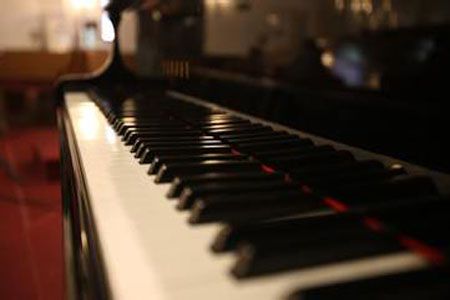
2017年第11屆德國達姆施塔特肖邦國際鋼琴比賽
達姆施塔特肖邦鋼琴比賽於1983年正式舉行,每三年或四年舉行一次。該比賽面向所有國家的優秀鋼琴家開放,參賽者年齡不能超過三十歲,旨在為世界各國優秀的年輕鋼琴家提供一個展示自我的廣闊平臺。由於該鋼琴比賽高端且名額有限,我們將對申請者進行嚴格的篩選。達姆施塔特肖邦鋼琴比賽力求尋求闡釋肖邦作品的最佳演奏方法,並鼓勵年輕的鋼琴家不斷堅持音樂藝術夢想,開啟自己的音樂旅程,在國際舞臺上大放異彩!
2017年第十一屆德國達姆斯塔特國際肖邦鋼琴比賽分為三輪,參賽選手經過一、二輪的激烈角逐後,進入決賽的選手將有幸和著名的帕爾杜比采室內愛樂樂團合作,共同演奏肖邦的鋼琴協奏曲。秉持公平公正的比賽原則,本屆大賽的評審團由國際著名音樂家組成,其中包括亞洲著名的鋼琴家鄧泰山,他是歷史上第一個在“肖邦國際鋼琴比賽”獲得冠軍的亞洲人,他們將嚴格按照評審標準,對選手的演奏水準進行公正的評估。
達姆斯塔特國際肖邦鋼琴比賽自成立至今已成功舉辦九屆,在2009年10月的第九屆比賽中,共有來自20個國家的62名選手參賽,有4名中國選手進入比賽,其中,年齡最小的古靜丹最終獲得第二名的好成績,這也將極大地鼓舞中國優秀選手的參與熱情。
2017年第11屆德國達姆施塔特肖邦國際鋼琴比賽將於2017年10月6日至2017年10月16日舉行,歡迎選手積極參賽!
比賽地點:德國 達姆施塔特
比賽時間:2017年10月6日 – 2017年10月16日 (共計11天)
報名截止時間:2017年6月1日
參賽要求:比賽面向生於1987年1月1日當天及以後的鋼琴家開放,不限國籍
備註:歷屆比賽的一二三等獎得主不得報名參加本屆比賽。
比賽演出形式有:
A. 鋼琴獨奏;
B. 鋼琴和管弦樂協奏(e小調op. 11 和f小調 op. 21);
C. 鋼琴和大提琴合奏;
D. 既定主題的即興演奏。
日程安排:
2017年10月6日(星期五19:30) 音樂會開幕典禮—鋼琴獨奏會;
2017年10月13日(星期五) 第一輪和第二輪比賽;
2017年10月15日(星期天) 第三輪比賽。
各輪比賽具體時間及內容:
第一輪:肖邦鋼琴獨奏
時間:2017年10月7-10日 09:00-13:00 和15:00-19:00;
內容:練習曲、瑪祖卡曲、波蘭舞曲、幻想曲、即興演奏;
第二輪:肖邦鋼琴獨奏
時間:2017年10月11-13日 09:00-13:00 和15:00-19:00;
內容:奏鳴曲、練習曲迴圈曲目、自由選擇曲目;
第三輪:鋼琴和大提琴的合奏,以及鋼琴和管弦樂團的協奏演出
時間:2017年10月14-15日 17:00-22:00;
內容:肖邦的鋼琴和大提琴的合奏曲;
E小調, op. 11 和F小調, op. 21的鋼琴協奏曲;
與俄羅斯室內管弦樂團合奏;
閉幕典禮:獲勝者音樂會演出,暨頒獎典禮
時間:2017年10月16日 星期一 19:30;
內容:獲勝者音樂會演出及頒獎。
參賽曲目:
COMPETITION REPERTOIRE 2017
to be performed from memory in any chosen order. Mazurkas to be performed as a
set, likewise études as a group or as a cycle in Round II. The National Edition of
Chopin’s Works, edited by Prof. Jan Ekier, is recommended, although any other
reliable edition (e.g. Paderewski) will be accepted.
l Round I (Maximum time: 30 minutes)
a) 3 consecutive études from op. 10 or 25 (e.g. op. 10 Nos. 1,2,3 or op. 10 Nos.
12,13,14 or op. 25 Nos. 6,7,8 etc.)
b) 1 full opus of mazurkas (free choice)
c) 1 polonaise (free choice)
d) 1 nocturne (free choice)
Optional Improvisation:
Candidates in Round I may, in addition to the above, choose to improvise for a
maximum of 5 minutes on a theme which was popular in Chopin’s time and which will
be given to them on the day. It is hoped that many candidates will attempt this, even
though it is not compulsory. Marks will not be deducted for a poor attempt. The time
for the improvisation will be added to the 30 minutes.
A prize of € 500 will be awarded for the best improvisation.
l Round II (Maximum time: 50 minutes)
EITHER:
a) 1 complete cycle of études, either op. 10 or op. 25. No études played in Round I
may be repeated in Round II.
b) 1 major/longer work lasting more than 8 minutes (e.g. scherzo, ballade, rondo,
Barcarolle, Fantaisie, Allegro de Concert etc.)
c) Any 1 or more works to make up a playing time of between 45 and 50 minutes
OR:
a) 1 sonata (C Minor, B Minor or B flat Minor) without repeats
b) 1 major/longer work lasting more than 8 minutes (e.g. scherzo, ballade, rondo,
Barcarolle, Fantaisie, Allegro de Concert etc. or in this section 8 consecutive préludes
from op. 28* (e.g. Nos. 3,4,5,6,7,8,9,10)
c) Any 1 or more works to make up a total playing time of between 45 and 50 minutes
*The 8 préludes, if chosen as a major work, must be played consecutively and may
only count as a major work in combination with a sonata.
No works played in Round I may be repeated in Round II.
Credit will be given for an interesting and balanced programme of works.
l Round III (Finals)
a) Concerto for piano and orchestra (E Minor op. 11 or F Minor op. 21)
b) The piano part of one of the following chamber works to be performed with a cellist
provided by the competition (use of score permitted for this work):
i. Introduction et Polonaise Brillante in C major op. 3
ii. Grand Duo Concertant on themes of “Robert le Diable”
iii.1st movement (Allegro moderato) of Sonata for Piano and Cello op. 65 in G Minor
iv. 2nd, 3rd and 4th movements (Scherzo, Largo and Finale-Allegro) of Sonata for
Piano and Cello op. 65 in G Minor
8 finalists will be accompanied by the RUSSIAN CHAMBER PHILHARMONIC ST.
l Principles determining the choice of repertoire:
By giving a large amount of free choice in Rounds I and II, we hope to motivate
candidates to explore the Chopin repertoire in more detail and discover for themselves
what combinations of pieces are desirable and possible. A well-balanced and
attractive programme might well assist the judges in making their final decision.
The opportunity for improvisation in Round I should be seen as an incentive for many
young pianists to explore and develop the art of improvisation, nowadays widely
neglected, especially since Chopin was such a great master of this.
With the inclusion of a chamber work in Round III (finals) we want to underline the
tremendously important role that chamber music played in Chopin’s life – a fact that is
frequently underestimated – and to give a hearing to these wonderful but far too
rarely performed works. The choice given should allow all participants to find a work
that best suits their personal situation.
評委組成:
KEVIN KENNER, 美國, 評審主席和藝術總監;
DANG THAI SON, 越南/加拿大
ANDRZEJ JASINSKI, 波蘭
MARTIN KASIK, 捷克共和國
TOBIAS KOCH, 德國
EWA POBLOCKA, 波蘭
備註:
ü 評審團由國際傑出的音樂家和音樂教授團隊組成;
ü 評審團的評審結果是最終的,不容置疑。
獎項設置:
3000歐元,以及音樂會演出機會;
具體獎項明細待公佈。









